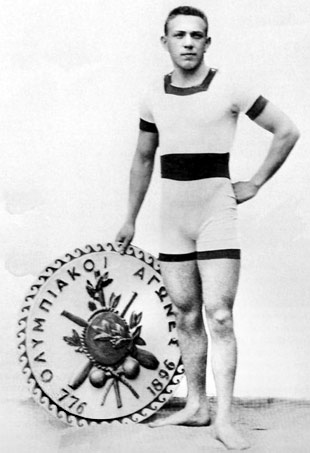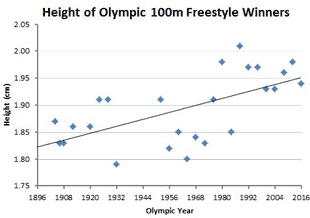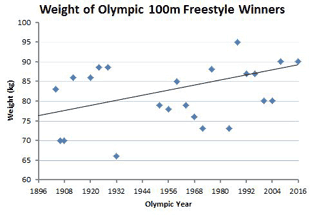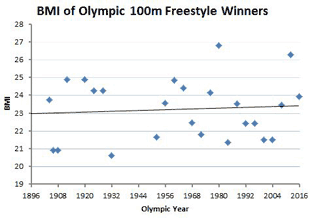The Olympic Games brings together the best swimmers in the world. Studying the changes in anthropometric measurements of the Olympic swimming champions can demonstrate how the size and shape of athletes have changed over 100 years of sport.
The Tokyo 2020 winner Caeleb Dressel has been added to the table, but the graphs have not been updated with his details.
 Alfréd Hajós, the 100m freestyle champion from 1896
Alfréd Hajós, the 100m freestyle champion from 1896Anthropometric Measures of Olympic Champions
Here is a table of the height, weight and body mass index (BMI) of the male Olympic 100m freestyle champions for nearly every Olympiad. The graphs presented below show how these measures have changed over time. Generally, the winning swimmers have become taller and heavier.
| Year | Winner | Time (secs) | Height | Weight | BMI |
|---|---|---|---|---|---|
| 1896 | Alfréd Hajós | 82.2 | |||
| 1900 | no event | ||||
| 1904 | Zoltán Halmay | 62.8 | 1.87 m / 6 ft 1.5 in | 83 kg / 183 lb | 23.7 |
| 1906 | Charles Daniels | 73.0 | 1.83 m / 6 ft 0 in | 70 kg / 154 lb | 20.9 |
| 1908 | Charles Daniels | 65.6 | 1.83 m / 6 ft 0 in | 70 kg / 154 lb | 20.9 |
| 1912 | Duke Kahanamoku | 63.4 | 1.86 m / 6 ft 1 in | 86 kg / 190 lb | 24.9 |
| 1920 | Duke Kahanamoku | 60.4 | 1.86 m / 6 ft 1 in | 86 kg / 190 lb | 24.9 |
| 1924 | Johnny Weissmuller | 59.0 | 1.91 m / 6 ft 3 in | 88.5 kg / 195 lb | 24.3 |
| 1928 | Johnny Weissmuller | 58.6 | 1.91 m / 6 ft 3 in | 88.5 kg / 195 lb | 24.3 |
| 1932 | Yasuji Miyazaki | 58.2 | 1.79 m / 5 ft 10 in | 66 kg / 146 lb | 20.6 |
| 1936 | Ferenc Csik | 57.6 | |||
| 1948 | Wally Ris | 57.3 | |||
| 1952 | Clarke Scholes | 57.4 | 1.91 m / 6 ft 3 in | 79 kg / 174 lb | 21.7 |
| 1956 | Jon Henricks | 55.4 | 1.82 m / 6 ft 0 in | 78 kg / 172 lb | 23.5 |
| 1960 | John Devitt | 55.2 | 1.85 m / 6 ft 1 in | 85 kg / 187 lb | 24.8 |
| 1964 | Don Schollander | 53.4 | 1.80 m / 5 ft 11 in | 79 kg / 174 lb | 24.4 |
| 1968 | Michael Wenden | 52.2 | 1.84 m / 6 ft 0.5 in | 76 kg / 168 lb | 22.4 |
| 1972 | Mark Spitz | 51.22 | 1.83 m / 6 ft 0 in | 73 kg / 161 lb | 21.8 |
| 1976 | Jim Montgomery | 49.99 | 1.91 m / 6 ft 3 in | 88 kg / 194 lb | 24.1 |
| 1980 | Jörg Woithe | 50.40 | 1.98 m / 6 ft 6 in | 105 kg / 231 lb | 26.8 |
| 1984 | Rowdy Gaines | 49.80 | 1.85 m / 6 ft 1 in | 73 kg / 161 lb | 21.3 |
| 1988 | Matt Biondi | 48.63 | 2.01 m / 6 ft 7 in | 95 kg / 209 lb | 23.5 |
| 1992 | Alexander Popov | 49.02 | 1.97 m / 6 ft 5.5 in | 87 kg / 192 lb | 22.4 |
| 1996 | Alexander Popov | 48.74 | 1.97 m / 6 ft 5.5 in | 87 kg / 192 lb | 22.4 |
| 2000 | Pieter van den Hoogenband | 48.30 | 1.93 m / 6 ft 4 in | 80 kg / 180 lb | 21.5 |
| 2004 | Pieter van den Hoogenband | 48.17 | 1.93 m / 6 ft 4 in | 80 kg / 180 lb | 21.5 |
| 2008 | Alain Bernard | 47.21 | 1.96 m / 6 ft 5 in | 90 kg / 200 lb | 23.4 |
| 2012 | Nathan Adrian | 47.52 | 1.98 m / 6 ft 6 in | 103 kg / 227 lb | 26.3 |
| 2016 | Kyle Chalmers | 47.58 | 1.94 m / 6 ft 4 in | 90 kg / 198 lb | 23.9 |
| 2021 | Caeleb Dressel | 47.02 | 1.91m / 6 ft 3 in | 88 kg / 194 lb | 24.1 |
source: height and weight data was collected from Wikipedia profiles of each athlete, and when none was available, from the sports-reference.com website.
Notes: No data was found for 1948 winner Walter "Wally" Ris, though he is described as tall and also looks it too in a photo found online.
Height changes over time
The average height of the Olympic 100m freestyle champion has significantly increased since the 1904 Games. The tallest winner has been Matt Biondi in 1988 at 2.01 m (6 ft 7 in), and since then all winners have been 1.93 m (6 ft 4 in) or taller.

Weight changes over time
The weight of the Olympic 100m freestyle champion has generally increased since the early Olympic Games, in line with changes in height. The heaviest was the 2012 winner Nathan Adrian at 103 kg / 227 lb. The 1932 winner Japan's Yasuji Miyazaki was only 66 kg (146 lb). Don Schollander in 1964 was just 1 cm taller, but weighed 13 kg (29 lbs) heavier.

BMI changes over time
The BMI of the Olympic 100m freestyle champion has varied from 20.6 up to 26.8. The current champion Nathan Adrian has a BMI of 26.3, a result of a large muscle mass (obvious from photos). Two time winner Alexander Popov was of similar height, but with much less muscle. He weighed 87 kg (192 lb) compared to Adrian's 103 kg (227 lb).

Note: This analysis is for illustrative purposes only. The data was from different sources, and may also not accurately represent their measurements at the time of their race.
Related Pages
- Details of the Olympic Games 100m freestyle
- Anthropometry of Olympic Athletes
- See a similar analysis of Olympic 100m sprint champions
- Athlete Body Size Changes Over Time
- Sport Specific Anthropometry, including Swimming Anthropometry
- about BMI
- Science and the Olympics
- Olympics Anthropology Days


 Current Events
Current Events